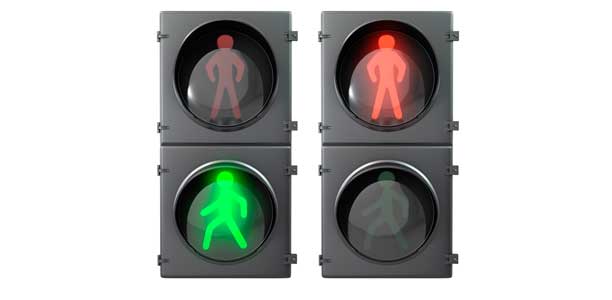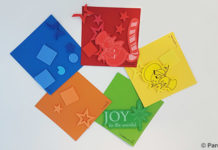Age
Babies to school age kids.
Suitable for babies who have started to walk (even those that aren’t very confident yet), toddlers and pre-schoolers. Even though older kids don’t need to practice their walking skills, they’re at an age where road safety is increasingly important.
Number of participants
For one or more players. When more than one child plays you could get them to take turns crossing the pretend road, or hold hands and cross together. If you have a large group, like a preschool class, you could split the children into two groups and get half to stand on each side of the pretend road, then cross in opposite directions when the walk sign comes up.
Duration of game
You can play this game for just a couple of minutes, or up to half an hour.
Materials/equipment
- Traffic light template
- Colour printer
- Laminator and laminating slips
- Blu-tac
Alternative cheaper version
- Paper
- Plastic cup
- Coloured crayons/pencils
Cost
$2
Printing and laminating will cost about $2.00 (if you already have the printer and laminator) and will mean this game is re-usable.
But don’t worry if you’re short on cash or don’t have the printer and laminator. You can still play this game by making your own template, using a paper cup as a stencil and colouring in the signs. You can put them in a plastic folder slip to make them last longer.
Preparation
With the use of the pedestrian traffic signs template provided, preparing this game is a simple matter of printing, cutting and laminating the signs. Download the printable version
1) Print and then laminate page 1 of the red and green traffic men.
2) Blu tac the laminated men page to the wall at your child’s eye level.
3) Print the black circle cover and laminate. Then cut around the laminated circle.
4) Use a piece of blu tac to stick the black circle over one of the traffic men. (It only needs to cover one, as the action to take is indicated by the uncovered one).
If you decide to go for hand drawn signs it might take a little longer to prepare, but they’ll work just as well.
How to play
- Prepare/setup game as per above instructions.
- Stand your child at the opposite side of the room- it’s often fun for your child to push a pram or carry a doll or teddy which is their ‘baby’ while playing this game, or you might want to stand them with their favourite doll or teddy.
- Tell your child that the space between them and the pedestrian traffic light is a road and they have to walk across the pretend road- but to make sure they get across safely with their baby, they must wait until the green man sign appears. This is when they know that all the cars on the road will stop and wait for them to cross the pretend road.
- Tell them that when the green man sign appears it means it is safe to cross and they should look in both directions and listen for traffic. If it looks and sounds safe, then they can then cross the pretend road.
- When the red man sign appears they must not cross the road as cars will not stop when the red man is on the sign. Instruct you child to wait whenever there is a red man on the sign.
- Use the black circle with a piece of blu tac, to cover either the red or green man traffic light circle. Your child should either wait (if the green man is covered and the red man is showing) or look, listen and cross (if the green man is showing).
Modifications on how to play
- Once your child gets the hang of crossing the road when the light is green and waiting when the light is red, you could have a bit more fun by adding sound to the game. Sometimes when the light is green you can make the sound of a truck or car approaching and in these cases your child should wait to cross, even though the green man sign is on.
- You could also encourage your child to say particular things (e.g. green means go or red means stop) when each sign comes up to improve their language skills further.
- Once your child knows all the rules well, you could even put the doll or teddy in the ‘wrong’ situation where the teddy is in the middle of the road on their own when the red light is on. The child has to call an adult to rescue the teddy while waiting on the pretend pavement. When the teddy is safe, you can then get the child to tell the teddy what they did wrong, by firstly not being with an adult and secondly crossing when it was red and explain why this is so dangerous.
Safety concerns
Although your child will learn important road safety skills from this game, they are still too young to apply these skills in real life situations. You must still supervise your child at all times when they are around cars, whether they are in your driveway or on a busy road. In real life situations, make sure you are there to hold their hand and teach them about road safety through real life experience, for example by talking to them about where to cross the road and when to cross. Young children can learn a lot by following the examples set by adults, so make sure you set a good example when you’re out and about on the road.
Benefits of this game/play
You child’s body grows more slowly after the first year but their little mind is developing rapidly. At this age most kids are full of energy and like activities which allow them to move and develop the muscles in their arms and legs. However, their attention span is short and they may want to change games constantly. This game is fast to set up and can entertain your child for a little or a long while (depending on how long their attention lasts).
Gross motor skills
- Walking across the pretend pedestrian crossing when the light is green is a great way to encourage your child to be active and the simple act of walking will be helping them develop the big muscles in their legs which are used for walking.
- Other actions your young child performs in this game such as holding a baby or pushing a pram will also help develop their arm muscles and their ability to coordinate their arms and legs to move at the same time.
Spatial awareness
- Spatial awareness or being able to locate oneself in relation to other objects in a space is a key part of road safety. For example, being aware of how wide a road is and how long it might take to cross.
- To enhance your child’s understanding of spatial awareness, talk about their location at different times in the game (e.g. waiting at the side of the road, in the middle of the road, across the road) and the relationship of different objects in the space (e.g. whether they are in font or behind) as you go. For slightly older toddlers you could even measure the distance across the road by counting the number of steps it takes them to reach the other side.
Communication and social skills
- At this age children start to develop an awareness that particular symbols communicate particular messages, for example that the green walking man means go and that the red standing man means stop. This game will increase your child’s awareness of symbols which communicate information about road safety. The two traffic lights are great symbols for young children, who are best able to tell the difference between symbols which have just one difference (e.g. a different colour).
- Getting a 2-3 year old to stand still can be quite a challenge. Learning to sit patiently at the traffic lights also helps children develop patience in real life- knowing they need to wait their turn to cross the road can also help them know that they have to wait their turn in other situations.
Language development/literacy
- Talking to your child seems like a simple thing, but at this age your child develops all their language skills through this simple act. The conversations you have during this game will help them lean new words and how to string words together in a sentence.
- As you talk to your child about the pedestrian traffic signs and help them decide whether or not it is the right time to cross, and what they are doing at any given time you’ll also be teaching them new words including words which describe spatial relationships, words like at, in, middle and across.
Maths skills
- Recognising patterns and colours is an early mathematical skill and your child will develop a better recognition of colours while playing the pedestrian lights game.
- Count the number of steps your child takes to cross the road and you’ll be helping them learn numbers and counting. Action games are a fun way to learn and maths should be fun- especially at this age.
- For a pre-schooler, ask them to guess how far the distance is across the road- they may not comprehend measures like metres yet, but they will be able to comprehend distance in an everyday measurement like steps.
Download the printable version
 |
Download the Traffic Light Template |
References
- Di Pietro G. Child Development and Road Safety- Relationship between age, development and road safety in children aged 0-16 years. Motor Accidents Authority. 2004. (cited 19 January 2013). Available from: (URL Link)
- US Department of Education. Teaching about numbers and counting. In Teaching our youngest- A guide for preschool teachers and child care and family providers. 2007. (cited 13 March 2013). Available from: (URL Link)
- American Academy of Pediatrics. The complete and authoritative guide- Caring for your baby and young child- birth to age 5. 5th ed. Bantum Books. 2009. Available from: (URL Link)
- Copley JV, Glass K, Nix L, et al. Measuring experiences for young children. Teaching Children Mathematics. Feb 2004. Available from: (Full Text)



 (11 votes, average: 4.18 out of 5)
(11 votes, average: 4.18 out of 5) 






